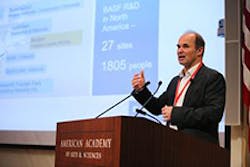NORA Research Center Gets Five-Year Extension
At the NORA Meets BASF Challenges conference in Cambridge, MA, Martin Brudermueller, vice chairman of the board of executive directors and chief technology officer, BASF, presents the BASF Innovation Approach – Partnering and Digitalization in R&D.
At a conference marking the five-year anniversary of the North American Center for Research on Advanced Materials (NORA), the center’s members convened to discuss the outcomes of the research alliance to date as well as future areas of focus, including bioscience and catalysis research, digitalization and working with start-up organizations. NORA was established by BASF, Harvard University, the Massachusetts Institute of Technology (MIT) and the University of Massachusetts (UMass) Amherst. At the anniversary event in Cambridge, Massachusetts, the extension of NORA for another five years was officially announced.To accelerate its development of digitalization in R&D, BASF announced at the conference its membership in Systems That Learn (STL), a research initiative that is part of the MIT Computer Science and Artificial Intelligence Laboratory (CSAIL). STL aims to accelerate the development, deployment and evolution of large-scale software systems that incorporate machine learning and artificial intelligence (AI). Membership will provide BASF access to cutting-edge research in AI, machine learning and data analytics, early access to new tools and close interaction with CSAIL researchers.
In recent years, the NORA initiative has reportedly led to significant advancements in the field of structured materials. Nature has perfected such materials, for instance, balsa wood – a prominent example of lightweight materials, balancing low weight and remarkable strength. A joint effort of BASF and MIT, Professors Lorna Gibson and Markus Buehler used a combination of experimental techniques and computer simulation to reveal more insights into the structure of balsa wood – from macroscopic specimens, to the level of the cellular structure of the wood, down to chemical details at the atomic scale. In looking at the smallest details, it was determined that the wood’s strength comes from cellulosic fibers reinforcing the walls in the cellular structure in a specific geometrical arrangement.
Once this principle was discovered, the NORA team created composite materials based on the characteristics of Balsa wood. Together with Professor Ryan Hayward from UMass Amherst, researchers mimicked the smallest elongated cellular structures in polymeric foams. A collaboration with Professor Jennifer Lewis’ group at Harvard used 3D printing techniques to print honeycomb cellular structures from epoxy resins, which contained reinforcing fibers in the cell walls, just like Balsa.
The NORA collaboration has also advanced tools and learnings that are being incorporated into several internal BASF projects. “As we look to the next five years, understanding and controlling structures of materials at all length scales will remain a focus area and an interdisciplinary effort at NORA, considering novel applications in chemical catalysis, materials for biological systems or exploring physical interactions in advanced and totally new materials, such as metamaterials,” says Dr. Peter Eckes, president of Bioscience Research and North America research representative at BASF. “We look forward to extending our co-creation efforts with our academic partners.”
For more information, visit: www.basf.com

